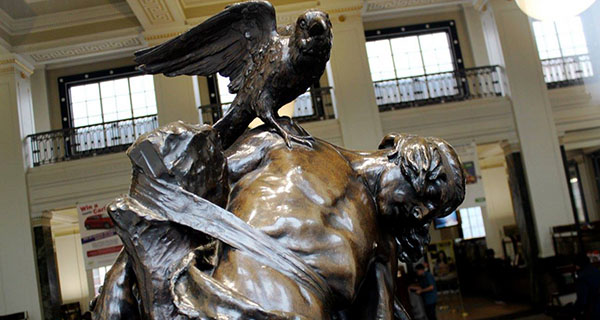 With St. Patrick’s Day almost upon us, it’s appropriate to write something with an Irish theme. And what better subject than the greatest hero of Ireland’s mythical past – Cuchulainn.
With St. Patrick’s Day almost upon us, it’s appropriate to write something with an Irish theme. And what better subject than the greatest hero of Ireland’s mythical past – Cuchulainn.
As the word is derived from old Irish, a bit of phonetic assistance would help. The variation familiar from my childhood is “Coo Cullen.” It may not look elegant when written, but it rolls easily off the tongue.
I was five or six years of age when my father took me to see Cuchulainn. I’d heard the story and fervently believed he’d been a real person, but I also knew he was dead. In fact, the heroic nature of his death was one of the attractions. Mid-20th century little boys were generally big on things like warriors, battles and such.
So, Cuchulainn being dead, I wasn’t sure what it was we were going to see. Perhaps my father had access to the body or something.
It transpired, though, that we were going to see a statue. Situated in the middle of Dublin’s bustling General Post Office, it was a large bronze piece depicting the Death of Cuchulainn.
Nude, except for a strategically placed loincloth, Cuchulainn is strapped to a pillar with a sword in one hand and a shield in the other. The fact that he’s dead is signified by the slumped posture of his body and the presence of a raven on his right shoulder. He died heroically, facing his enemies.
But while the image fitted the story, I’ve a vague recollection of being mildly disappointed. Shouldn’t there be more than this?
The Cuchulainn narrative is part of what’s known as the Ulster Cycle of early Irish sagas and has several dimensions and variations. The most famous – and the one associated with his death – is the tale of the Cattle Raid of Cooley.
The version I heard as a child is set around the beginning of the first century, with pre-Christian Ireland divided into several competing kingdoms, two of which would be roughly synonymous with the modern Irish provinces of Ulster and Connaught. The plot’s driver is Queen Maeve of Connaught’s desire to acquire a prize brown bull that resides in Ulster.
Frustrated in her acquisition attempts, Maeve decides to do it the old fashioned way – by sending an army. But because the men of Ulster are incapacitated by a magic curse, only Cuchulainn is available to resist.
Still, he’s spectacularly successful for a while, even counting his best friend, Ferdia, among his victims. Ferdia, alas, had become Maeve’s champion and thus the two friends are tragically pitted against each other.
Eventually, Cuchulainn is fatally wounded and straps himself to the pillar so as to die facing his enemies. And his reputation being what it is, they daren’t approach him until the raven alights on his shoulder and sips his blood, thereby signifying his demise.
As stories go, this one has real durability. Manuscript versions date to the late 11th and early 12th centuries but there are poetic references as far back as the seventh century.
There was even a period when some scholars believed the rendering to be essentially true, a valid piece of history. Heroic mythology is like that, testifying to the universal attraction of gripping versions of the past. The human imagination wants what it wants.
Then there’s the matter of socio-political appropriation.
The Gaelic cultural revival of the late 19th and early 20th centuries consciously set out to restore the Irish language and reboot Ireland’s traditional customs and heritage. The old stories and myths were natural fodder for this movement and the tales of Cuchulainn were a perfect fit for the literature of the period. Indeed, I suspect that’s how my parents came to know them.
Politics, too, wasn’t far behind.
Although Oliver Sheppard’s bronze statue – the one that I saw as a child – predates the 1916 nationalist insurrection, the Irish government of the mid-1930s decided to designate it as an official memorial. Hence it was purchased and located in Dublin’s General Post Office.
Appropriation, however, is an accessible thing. During Northern Ireland’s infamous Troubles, Ulster loyalists – the polar opposites of the nationalists who placed the statue in Dublin – adopted Cuchulainn as a symbol of their determination to resist what they saw as nationalist attempts to sever them from the United Kingdom.
Myths, it would seem, can’t be exclusively owned.
Troy Media columnist Pat Murphy casts a history buff’s eye at the goings-on in our world. Never cynical – well, perhaps just a little bit.
The views, opinions and positions expressed by columnists and contributors are the author’s alone. They do not inherently or expressly reflect the views, opinions and/or positions of our publication.


